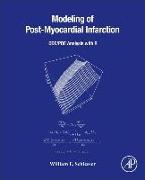Modeling of Post-Myocardial Infarction
BücherAngebote / Angebote:
Modeling of Post-Myocardial Infarction: ODE/PDE Analysis with R presents the formulation and computer implementation of mathematical models for the dynamics of a post-myocardial (post-MI), also termed a heart attack. Survivors of a post-MI are likely to experience a reduced (impaired) cardiac function. This results from a series of post-MI biomolecular reactions that are modeled in this book by systems of ordinary and partial differential equations (ODE/PDEs). Initially, monocytes and myocytes are produced in a post-MI that then react to produce macrophages and cytokines, which may adversely affect the cardiac tissue such as inflammation and reduction (weakening) of the extra cellular matrix (ECM). The mathematical models discussed in this book consist of a system of six ordinary differential equations (ODEs) with dependent variables Mun, M1, M2, IL10, Ta, IL1. The system variables are explained as follows: dependent variable Mun = cell density of unactivated macrophage, dependent variable M1 = cell density of M1 macrophage, dependent variable M2 = cell density of M2 macrophage, dependent variable IL10 = concentration of IL10 (interleuken-10), dependent variable Ta = concentration of TNF-a (tumor necrosis factor-a), dependent variable IL1 = concentration of IL1 (interleuken-1). The system of six ODEs does not include a spatial aspect of an MI in the cardiac tissue. Therefore, the ODE model is extended to include a spatial effect by the addition of diffusion terms. The resulting system of six diffusion PDEs, with x (space) and t (time) as independent variables, is integrated (solved) by the numerical method of lines (MOL), a general numerical algorithm for PDEs. The infarction of the MI can be spatially variable within the PDE diffusion (cardiac tissue) model. This spatial variation is analyzed through changes of the monocyte and myocyte volumetric generation rates. The six ODE models presented in the book can be used for computer-based experimentation via the R routines. For example, parameter variation and changes in the model equations or alternate models can be studied to enhance a quantitative understanding of a postulated post-MI. The routines are available from a download link so that the example models can be executed without having to first study numerical methods and computer coding. As additional background, a library of PDE routines is available to readers to support the research in the book. These library routines pertaining to PDE analysis have received over 1, 200, 000 visits.
Folgt in ca. 15 Arbeitstagen
